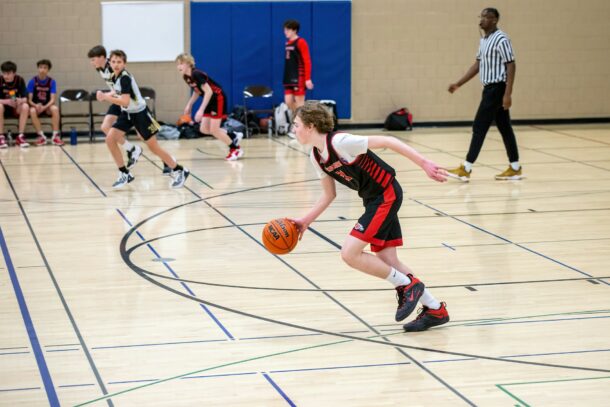Welcome to our basketball coaching blog, where we dive deep into the strategies and tactics that can turn a good team into a great one. Today, we’re about to unveil the ultimate weapon in a coach’s arsenal – “zone busters.”
Zone defenses can be formidable obstacles on the basketball court, but with the right knowledge and execution, your team can crack even the most impenetrable zones. In this post, we’ll explore the art of attacking zone defenses, breaking down the key principles, strategies, and plays that will make your team a force to be reckoned with on the court.
So, whether you’re a coach looking to add some firepower to your playbook or a player seeking to excel in any situation, let’s dive into the world of zone busting and unlock the secrets to offensive success.
7 Universal Zone Busters to Use This Season
Zone busters are specific offensive strategies or plays designed to exploit weaknesses in a zone defense. They are tactics used to break down the defensive structure of the opposing team when they are playing a zone defense, which typically involves players guarding specific areas of the court rather than individual players.
Zone busters can involve quick ball movement, sharp perimeter shooting, player positioning, and penetration to create scoring opportunities within the zone. The goal is to force the zone defense to collapse or shift, creating open shots or passing lanes for high-percentage scoring chances. Successful execution of a zone buster can make the difference between struggling against a zone defense and scoring consistently.
1. Dribble Penetration
Dribble penetration is quickly becoming the number one method that teams are utilizing when faced with a zone defense. One of the reasons teams are implementing dribble penetration is due to the decreasing number of skilled shooters today.
To become a great shooting team, coaches have to take valuable time out of their practice to focus on the necessary repetition of shooting drills, and many have to work tediously on correcting shooting form. Many players today are better ball handlers than shooters, and so it is easier and takes less practice time to play to their strengths.
Dribble penetration is most effective when players are attacking the gaps. Penetrating the gaps forces the defense to pinch in and stop the ball, leaving both inside and outside outlet options available.
2. Ball Reversal
Perhaps the most common instruction coaches will verbalize to their players when facing a zone is “ball reversal.” Reversing the ball forces the defense to shift as a whole unit from side to side, and if just one defender is slow in shifting, the whole zone will become distorted and openings will appear.
However, what coaches should be stressing is QUICK ball reversal, as this is what can often make or break a zone offense. At first, your team’s tendency will be to look at the basket right away for any immediate scoring opportunities, but doing this will give the defense an extra fraction of a second to recover. You may get a good shot right away, but ball reversal can get you a great shot!
On a side note, most players and teams do not utilize the skip pass enough. Skipping the ball over the top of the zone, usually from wing to wing, can provide shooters with wide-open looks, since defenses are often not prepared to react that quickly.
3. Flashing to the Middle
Sending one or more players flashing or breaking into the middle of the key forces the zone to immediately react, collapse, and cover up. When the defense collapses, shooters will be free to spot up on the perimeter for catch-and-shoot opportunities, and baseline runners will be able to move in from underneath the zone.
There are two main ways to flash to the middle. (1) with a post player breaking up from the block to the high post. And (2) breaking a perimeter player in from behind the defense (weak side), where the defenders can’t see him coming.
4. Behind the Zone
Working the baseline is one of the most underused principles of attack. In fact, many coaches instruct their players to intentionally avoid the baseline in fear of the baseline acting as a 6th defender. If you are one of those coaches, then you are denying your team three distinct advantages.
Attacking from behind a zone: (1) gives your players an inside rebounding position;(2) allows your team to easily post up against any zone; and (3) keeps the bottom line of the defense busy and also forces them to play lower (closer to the baseline), which stretches the zone and creates bigger gaps in the middle.
5. Screening the Zone
Another major way to attack any zone is to simply screen the defense. For years, coaches shied away from this technique, believing that it could only be used effectively against man-to-man defenses.
On-ball screens, flare screens, back screens, cross screens, and screens for baseline runners are all extremely effective against zone defenses when used properly. The best zones are very similar to sloughing man-to-man – take advantage of this fact and get some screens into your offense.
6. Fast Break
One of the easiest ways to defeat a zone is to simply get out and run, run, run! In order to set up a zone, the defenders need time to get back into their rightful spots, especially those who play at the bottom of the zone.
Even though defensive guards are usually the first ones back, they often stop at the top of the circle, and this leaves the basket unprotected. I can guarantee that your point guard is faster than their 5-man, and so if you can consistently beat the defensive center down the floor, your opponent will be in big trouble.
7. Crash the Boards
A topic of great debate over the years has been whether crashing the offensive boards should be considered a legitimate method of attack. The answer completely depends on your team’s mindset! By crashing the boards aggressively and fearlessly, you are putting tremendous pressure on the defense to box out.
In a zone, defenders are not matched up to a man, per se, but rather an area, which makes it much harder for defenders to box out. Since they don’t have specific box-out responsibilities, zone defenders often turn and watch the flight of the ball every time a shot is taken, which makes it even easier for offensive rebounders to get to the rim untouched.
For what it’s worth, we send four players to the offensive glass every time we play against a zone. Occasionally, our best zone offense has been to simply get the ball up on the glass and let our four rebounders relentlessly go after it.
Zone Busters!
Championship offenses to destroy any zone defense!
This easy download provides detailed breakdowns of 18 different offensive strategies that will dismantle any zone defense a team might try.
Some of what you’ll find in this offer includes important concepts to consider when facing a zone, and universal methods to deploy when attacking this defensive strategy.
This incredible sale item also includes detailed notes on motion offenses and several quick hitters to use when trying to catch the defense unprepared.
For more, check out Coach Collins’ latest sale item today!
Related: The Basketball Leadership Podcast
Resources:
Coach Unplugged Podcast:
If you found this useful, don’t forget to check out additional blog posts at TeachHoops.com. Also, check out TeachHoops on Facebook, Twitter, Instagram and YouTube.









